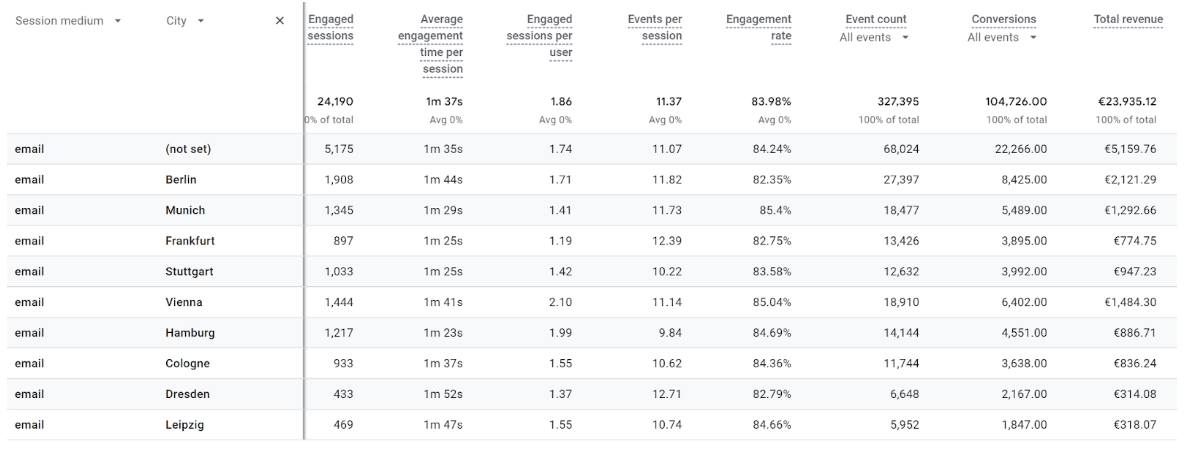How to measure the impact of email campaigns?
If you plan email marketing campaigns you are interested in the same as with other campaigns, to measure their impact on your business. When you are starting with this topic it is good to know that without additional effort you will not be able to access this impact. You will see no results because Google Analytics will treat traffic from the email campaigns as direct traffic (when users are using your own app) or as referrals (when users are using web email clients).
In the same way if you don't implement any additional tracking code on your website you will not see any meaningful stats in your email campaign provider tool. It is definitely not a desirable situation that's why we present what is worth doing to measure email campaigns. Below we show two perspectives and best practices from both perspectives: Google Analytics and email provider tool.
Google Analytics perspective:
How to make email campaigns visible in Google Analytics 4?
Like with other campaigns to be visible in GA4 you need to implement UTM tracking. This is the best and most simple way to assign your email marketing efforts to the appropriate channel in Google Analytics.
UTM is short for Urchin Tracking Module. Okay, but what is an UTM tracking?
A UTM tracking is a special code that you need to add to a website URL. For example, if you have a website: mywebsite.com you need to add this code at the end of it like that:
Mywebsite.com? UTM...
UTM tracking has a couple of parameters. Below in the table you will find a full list of them:
| Name | utm_parameter | Required |
Example | Description |
| Campaign ID | utm_id |
No | #123456 | This is a unique parameter with specific code ESP campaign code name identifier,. Can be useful when you do a lot of email campaigns. |
| Campaign source | utm_source | Yes | Klaviyo/Getresponse/Yourwebsite /Affiliate_name |
Your email service provider or if don't need to distinct it you can use this parameter to identify campaign segment/list or flow name (ex. vip-list, abandoned-cart) |
| Campaign medium | utm_medium | Yes | Name of traffic medium | |
| Campaign name | utm_campaign | No | black_friday_25_11_2022 | Name of your campaign, good to add date here. identifies campaign/flow specifics such as message name, type or other info. |
| Campaign term | utm_term | No | loyalty_buyers | You can use this parameter to indicate database you are using or for example to distinct easily traffic that come from manual campaign versus automated triggers |
| Campaign content | utm_content | No | check_offer_button | To define a specific link in your email content. Great parameter to track link CTA or images alt text (show to customer that disable showing images in their email client - gmail default) |
The most popular UTM builder you can use is the one created by Google: https://ga-dev-tools.web.app/campaign-url-builder/
An example utm email tracking scheme.
The final link in your email campaign may look as follow:
mywebsite.com/back-friday-offer
?utm_id=123456
&utm_source=klaviyo
&utm_medium=email
&utm_campaign=black_friday_25_11_2022
&utm_term=loyalty_buyers
&utm_content=check_offer_buttonSo UTM tracking includes a list of different parameters that allows you to check how specific campaigns, customer databases, call-to-action buttons, or providers drive results.
When to use '?', and when "&".
The rule is simple, the first parameter in a website URL should start with "?", and the rest with "&". This rule applies to every parameter included in the URL not only to campaign parameters. Because of that, you have to be careful and check if the landing page already does not have any parameters already. For example, if your landing page looks as follows:
mywebsite.com?offer=black_friday you should start add your parameters starting from "&" like here:
mywebsite.com?offer=black_friday
&utm_id=123456
&utm_source=klavio
&utm_medium=email
&utm_campaign=black_friday_25_11_2022
&utm_term=loyalty_buyers
&utm_content=check_offer_button
What kind of reports in GA4 and metrics will be important to evaluate the effects of email campaigns?
The default place in Google Analytics 4 when you should start to check your email campaign impact will be the Traffic acquisition report located under the acquisition group of reports. When you filter it to see just the email medium, you will have all important KPI's assigned to email traffic.
What kind of metrics are important for you will depend on the type of your business website. In the above example, we have a report for e-commerce so above all, conversions and revenue will be important to us. When you split medium by an additional dimension you can check which email database works for you the best.

Or you can check how specific CTA included in email creation drove traffic and conversions:

You can for example check how your email campaign perform in a specific regions:

You can check how your email campaign impact to your core KPI's in different attribution models:
As you can see after configuring UTM tracking for email campaigns you can do a lot of analysis. But of course, you are just limited by your creativity. Also, not only the analysis could be useful for you. You can also for example create a segment from email campaign users and exclude them from your other marketing activities or the other way round you can give them higher priority and budgets if you know that is an important group for you.
Email provider perspective:
Setting up tracking email provider tool.
For most ESPs (email service providers) it's covered out of the box, but there are some things you should keep in mind. For your email campaign to succeed you need to monitor at least a couple of main metrics such as Subscriptions, Delivered, Opened, and Clicked emails, Placed Orders, and Unsubscriptions. This gives you access to an overview of the main email marketing factors.
- Database growth - with a number of new subscribers to your database you can monitor churn and the health of your customer base. Most of the ESPs like Klaviyo give you the functionality to integrate with eCommerce platforms like Shopify or Woocommerce to help with gathering new leads during checkout or by using dedicated popups, signup forms, or other marketing tools (integration with FB to gather users via FB leads ads) forms or other marketing tools (integration with FB to gather users via FB leads ads),
- Deliverability - one of the most important email marketing factors which indicate how good your reputation is and where your email will be placed in your customers' inboxes. If you see any indication of deliverability below 97% it could mean that you should check your configuration. Advanced ESPs like Klaviyo gives you many options for setting up shared or dedicated IP as well as dedicated subdomain and tracking links.
- Email performance - Open rate, Click Through Rate (CTR), and Conversion Rate are important indicators of how your design, tone of voice, and offer work for your audience. Most ESPs give you this out of the box without any additional configuration but it's worth knowing how it's set up.
- Opens - are tracked by a small 1px image that is put in HTML in the header or footer of your email campaign. After customers download images to see the full design of your email this px is also downloaded and the ESP receives info that they viewed the email. Recently due to many privacy changes like the default blocking of images in some email clients (Gmail) or privacy restrictions made during iOS updates this factor has become much more unreliable. If you want to build engagement segments of customers based on email opens and the majority of your clients use iPhone devices - you should exclude automatic opens generated by the system. In Klaviyo you could use a property that identifies all customers who block tracking by pixel.

Also, in ESPs that use WYSIWYG (what you see is what you get) HTML editors you can decide where you want to put your tracking pixel. By default, the pixel should be placed at the bottom but if your emails are very long some email providers (like Gmail) can truncate it. So, to ensure tracking, you should put it in the header.
- Clicks - the most accurate email factor, it's tracked by the obfuscated link implemented automatically by ESP. This link uses different dedicated short domains to redirect to the final link that you put in your email. For example:
- https://trk.klclick.com/ls/click?upn=ik1CP44SQY
https://r20.rs6.net/tn.jsp?f=00189MeEc2,
- Each time this link is executed it is counted as one click, the system tracks unique clicks and multiple clicks made by each user.
- Conversion rate - an e-commerce factor that evaluates your action done with email marketing. To measure it in ESP you need to be integrated with your e-shop platform. Most of the service providers allow easy plug-and-play integration so no coding skills are required. Sometimes you need to paste a script into your e-shop theme or use the public API provided by ESP. After proper integration, you will have all the transaction data from the website inside your email marketing system. Besides tracking revenue and conversion you can create A/B tests with order rate as a success metric.
- Opens - are tracked by a small 1px image that is put in HTML in the header or footer of your email campaign. After customers download images to see the full design of your email this px is also downloaded and the ESP receives info that they viewed the email. Recently due to many privacy changes like the default blocking of images in some email clients (Gmail) or privacy restrictions made during iOS updates this factor has become much more unreliable. If you want to build engagement segments of customers based on email opens and the majority of your clients use iPhone devices - you should exclude automatic opens generated by the system. In Klaviyo you could use a property that identifies all customers who block tracking by pixel.
- Engagement - besides all indicators of the interaction of your subscriber with your brand (active on-site, email openers and clickers, active buyer, reviewing products, contacting support, posting on social media), unsubscription rate is crucial to identify how your campaigns perform. A high unsubscription rate could mean that your subscription process is not clear enough or your emails have display problems. If you see a bump in unsubscription it could also mean some deliverability issue with a specific email client or with your email-sending infrastructure.
Why is it worth implementing additional tracking on your website?
One thing is to setup utm parameters as was described above. If you properly set up utm tracking on the ESP side you can easily track your results in GA4. As an example, in the Klaviyo system, you can automate and customize the creation of parameters directly in the settings menu. You can leave the default configuration or you can adjust it to your needs. One parameter that shouldn't be changed is utm_medium as this defines the traffic source as an email channel.
You can play with parameters to use them to test and learn more about your campaign in GA4:

But to see metrics like conversion rates in your ESP tool you need to implement ESP tracking code on your website. Only then ESP tool will know if specific action was performed or not. To do that you have you use ready integration like for example between Shopify and Klaviyo or you need to implement ESP trackink code manually. The ESP tracking code should be implemented directly on your website, but you can use for that purspose Tag Managment system like Google Tag Manager.
Google Analytics tracking vs your email service provider reports
Probably the best strategy is to use both tools to get as much data as possible. You can also consider building one report with all important data from different sources. It’s possible with the help of additional tools like Supermetrics. If you are using a popular email provider like Klavio you will be able to automatically import all your data from Klavio and Google Analytics to Google sheet and report it in Looker Data Studio.

Piotr Ulacha
Piotr Ulacha is a web analyst. He has 15 years of experience in the digital marketing area. He specializes in implementation of analytical and marketing tracking codes, creating dashboards and data privacy topic. He works currently as a Web Analyst at EverStores.com where he implement tracking solutions for eCommerce brands. Previusly he worked at SellerX with eCommerce brands and at Artegence where he analyses the impact of marketing campaigns for Volkswagen Poland.
Jakub Borowiecki
Jakub Borowiecki has 15 years of experience in the digital marketing area. He is specialized in e-mail marketing, CRM, AdWords, e-commerce, web analytics, usability, HTML, CSS.
If you enjoyed the article please share it:
The article "How to Configure User ID in Google Analytics 4" by Julius Fedorovicius, published on Analytics Mania, provides a comprehensive guide on implementing User ID tracking in Google Analytics 4 (GA4). This feature enables businesses to monitor user interactions across multiple devices and sessions, offering a unified view of user behavior.
 Review of Julius Fedorovicius' article
Review of Julius Fedorovicius' article Jan 06, 2025
Jan 06, 2025Susan, an e-commerce entrepreneur, runs a thriving online store selling home decor. One day, her purchase funnel started showing a steep drop-off at the payment page. Unfortunately, Susan was unaware of this issue until weeks later, after losing significant revenue and customer trust. Why? She didn't have custom GA4 alerts set up to monitor her website metrics in real-time.
 Published by Piotr Ulacha
Published by Piotr Ulacha Dec 30, 2024
Dec 30, 2024Environment - is a set of necessary elements of technical / software infrastructure, which is the basis for the operation of a given website/application. Google Tag Manager environments are simply multiple versions of the same container. When we have a website with a different version for development, testing, production and QA, instead of creating separate GTM containers for each version, we can set up separate environments in the same container that will work independently in each version.
 Published by Anna Bacciarelli
Published by Anna Bacciarelli Jan 17, 2023
Jan 17, 2023Some time ago I listened to a podcast from the Technical Marketing Handbook series from Simo Ahava, whose guest was Adam Halbardier from the Google Tag Manager product team. During the conversation, the topic of transparency of data handled by the Server-Side container appeared.
 Published by Mariusz Michalczuk
Published by Mariusz Michalczuk Dec 04, 2022
Dec 04, 2022



